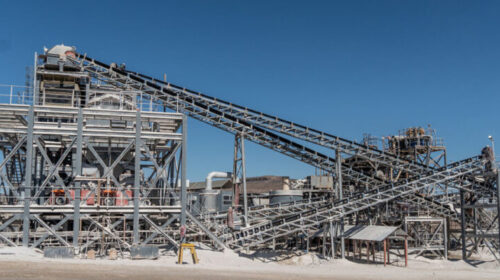U&M and Hexagon ready to deploy AHS solution at Brazil mine
U&M Mineração e Construção S/A, as the largest native open-pit mining contractor in the Americas and one increasingly focused on sustainability, is about to embark on a major autonomous haulage project that could prove transformational for all sizes of mine sites across the globe.
The company has been busily working on an in-house Autonomous Haulage System (AHS) for several years, enlisting the help of Hexagon’s Mining division back in 2020 to ensure what it delivered to the market was a commercial proposition with widescale applicability, IM discovered this week at HxGN LIVE Global 2023 in Las Vegas.
Now the companies are ready to deploy their combined OEM-agnostic AHS solution at a mine in Brazil, starting next month, as part of a plan to bring two AHS-enabled retrofitted Caterpillar 777 trucks to the operation.
The collaboration is seeing U&M carry out all mechanical changes to the 100-ton-class payload trucks to make them automation-ready without disturbing the OEM system.
The contractor is also in charge of the navigation system and software that the trucks will run on – the ‘autonomous driver’ as it could be termed.
Hexagon, for its part, provides the HxGN Autonomous Mining Mission Manager Solution to optimise the movement of autonomous and non-autonomous vehicles, and mine production activities through one interface; the World Perception solution to enable object detection, operator vehicle-to-vehicle and vehicle-to-person awareness; and some additional on-board infrastructure – such as sensors and an antenna.
This, according to the companies, makes for an autonomous contractor solution that can be rolled out anywhere in the world.
“The first project may involve Cat 777s, but what we are creating is a scalable platform that can be used on any truck,” Mauricio Casara, Commercial Director at U&M, told IM. “We are looking to improve on the legacy AHS solutions by making automation available to any size of mine with any type of trucks.”
As part of the company’s R&D work to this point, it has also retrofitted an autonomous solution on a Komatsu 730E, with that truck running at its proving grounds in Brazil.
Interestingly for this proof of concept involving the two Cat 777s, the plan is to enable the trucks to interact with both autonomous and manned vehicles in the haulage cycle from the off: an interaction that the traditional AHS providers have only just started to work on after more than a decade of industry deployments.
This is just one of the hurdles the solution will overcome, according to Andrew Crose, Vice President, Autonomous Mining, Hexagon’s Mining division.
“The world perception sensor stack that we have on board these machines will allow us to distinguish between trucks, light vehicles, berms, people and many other objects,” he said. “By leveraging this, we can ensure the trucks operate as safely as possible while being as productive as possible. That is key to achieving buy-in from all stakeholders involved.”
While the official partnership for this project was not signed until 2020, U&M has been utilising the GNSS positioning smarts of Hexagon – through the NovAtel business it acquired – for many more years.
This same GNSS solution is being leveraged in the two-strong autonomous truck trial along with V2X, 4D Radars, ultra-wideband time-of-flight systems and more.
Crose added: “It’s worth mentioning that around 60% of the autonomous machines running in the field have some Hexagon solution on them.
We are sometimes providing the positioning, world perception, fleet and mission management, onboard autonomy and by-wire, all part of our interoperable strategy.”
While this initiative is inevitably going to pique the interest of those companies in charge of running these autonomous trucks, U&M has no plans to compete with the likes of Caterpillar and Komatsu when it comes to manufacturing automation-ready trucks.
“There are so many existing trucks out in the field that our clients are running; all of which can be retrofitted with the solution we are working on,” Casara said. “The whole industry talks about sustainability and how to mine sustainably, but the sustainable solution to achieving autonomous operations is not to build brand new trucks and equip them for automation; it is to retrofit the smarts onto them to enable that automation.
“This is the sustainable way to roll out the automation needed across the sector to achieve mining companies’ productivity and decarbonization goals.”
![]()





